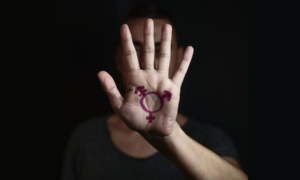A flurry of new reports charges that minority youth get unequal treatment in the criminal justice system – yet costly efforts over the past decade to rectify the problem have produced few results.
The latest report may be the most comprehensive effort ever to quantify disproportionate minority confinement (DMC), demonstrating that black and other minority adolescents are treated more severely than white youngsters across all levels of the juvenile justice system. Among the findings in “And Justice for Some”: black youngsters, 15 percent of the youth population, represent 26 percent of the youths arrested. Black youths with no prior record of detention are six times more likely to be incarcerated than are white youths in similar circumstances. Thereafter, the statistical disparities between minority and white youths widen, suggesting that black youths in particular are viewed by justice decision-makers as more dangerous.
The report, released in late April, was commissioned by the Building Blocks for Youth Initiative, a coalition led by the Youth Law Center, and underwritten by (among others) the U.S. Office of Juvenile Justice and Delinquency Prevention (OJJDP) and foundations such as Annie E. Casey, Ford, and the George Soros Open Society Institute. It uses several data sources, including FBI Uniform Crime Reports and OJJDP reports.
Its claims have been heard before. Yet pending congressional legislation would eliminate a requirement that states try to reduce DMC ratios in their juvenile justice systems, and existing reduction efforts do not seem to have produced much change.
“Very few places have come up with a meaningful strategy, much less a change in the numbers,” says Bart Lubow, senior associate with the Annie E. Casey Foundation, whose Juvenile Detention Alternatives Initiative supports creative alternatives to incarceration of youth.
Congressional Threat
“Youth of color are over-represented at each point in the system, and the disadvantage accumulates as they move through the system,” says the report’s co-author Michael A. Jones, senior researcher with the National Council on Crime and Delinquency, based in Oakland, Calif. Jones acknowledges that his report contains little new data; its strength is that it is much wider in scope than previous efforts.
However, the weight of evidence about DMC in juvenile justice may be reaching a critical mass. In December, an OJJDP report cited similar statistical evidence of the disparities in juvenile justice. And in early May, a report on the overall criminal justice system by the Leadership Conference on Civil Rights also cited inequities faced by minority youth. “The color of a person’s skin,” this latter report says, “is a better indicator of whether or not a juvenile is tried as an adult than any other.”
But even as statistical evidence on the DMC problem mounts, conservative Republicans in Congress are hoping to ax a Justice Department requirement that states must determine whether the proportion of detained minority juveniles exceeds their proportion in the population and if so, to develop corrective strategies. In 1992 Congress elevated the concern to a “core requirement,” meaning states failing to address DMC issues could forfeit 25 percent of their annual OJJDP formula grants.
Conservatives like Sen. Orrin Hatch (R-Utah) say that raising the issue of race in this way, in effect, sets racial quotas or limits on the acceptable number of minority youths who can be detained for crimes they commit. “You still can’t ignore the fact that these kids are committing crimes,” Hatch said during the 1999 Senate floor debate on the issue. “It doesn’t solve the problem by saying states should find a way of letting these kids out.”
Republican efforts to eliminate the federal DMC requirement passed the Senate last year but were defeated 414-16 in the House. It remains among unresolved issues that have stalled the 1999 Juvenile Justice bill in conference committee.
“Actually, the core requirement is pretty weak,” says Denise Forte, legislative director for Rep.”Bobby” Scott (D-Va.). Republican efforts to eliminate the requirement leave it “always at risk,” she says.
But is the requirement accomplishing anything?
Little Impact
After more than a decade of OJJDP-funded efforts, experts are hard pressed to cite more than a few local programs that have actually come close to denting DMC figures.
Since 1988, most states have undertaken studies, set up task forces or “initiatives” and hired consultants on DMC issues. OJJDP funded pilot initiatives in five states: Arizona, Florida, Iowa, North Carolina and Oregon, but only Oregon is routinely cited as close to producing an actual shift in minority confinement statistics.
“I think we’re just starting to see some success, but most places, it’s a little early in the process,” says Marc Schindler, staff attorney for the Youth Law Center in Washington, D.C.
Lou Biondi, executive vice president of CYGNUS Corp., a Rockville, Md., firm that consults on DMC issues, is less optimistic. He says millions of dollars are being spent on “fact-finding and overlapping programs” without producing a satisfactory DMC reduction plan for any state.
“You have to start with the premise that the system is broken; the system has been broken for 100 years,” Biondi says, “and no one is approaching the issue from the perspective of true systematic change.”
Says Lubow of Casey, whose alternatives to detention initiative includes Oregon’s Multnomah County.: “Because there’s been such a paucity of examples where they’ve been able to flip the [DMC] numbers, Portland gets a lot of attention.”
Striving to Be Objective
Oregon has a relatively low minority population: only 1.4 percent black and 4 percent Hispanic in the 1990 census. But the Oregon Youth Authority reports that from 1990 though 1997, the percentages of pre-trial detainees in Multnomah County, which includes Portland, dropped from 15 percent to 6 percent for whites and from 24 percent to 9 percent for blacks. For Hispanic youth, the drop was from 34 percent to 12 percent.
Lubow calls the effort “a modest first step.” Among the strategies used to cut pre-trial detention figures in Multnomah County is a “risk assessment instrument,” which turns out to be a simple form that attempts to bring objectivity to the screening of arrested juveniles. The form uses a point system to rate factors like the seriousness of the charges a youth faces or the youth’s prior criminal record, theoretically removing biases (like a youth’s clothes or home neighborhood) that might affect more subjective decision-making.
Don’t most juvenile justice jurisdictions try to be objective? “Don’t be so sure,” says Lubow.
A 1998 University of Washington study of three counties in that state found that probation officers consistently attributed crimes committed by black youths to aspects of their character, while the crimes of white juveniles were often blamed on negative influences or environmental factors. As a result, said the study led by sociology professor George S. Bridges, black youths were seen as more personally responsible and blameworthy, and the probation officers recommended them for harsher sentences.
Juvenile justice workers are also increasingly aware of studies pointing out how old attitudes and assumptions can affect how minorities are treated. William Feyerherm, vice provost of research at Portland State University, says assumptions that a two-parent family is more “stable” can influence decisions made about minority youth, who disproportionately come from single-parent homes.
Feyerherm, author of the “systematic analysis model” of DMC issues used by OJJDP, agrees that confinement decisions are too easily influenced by factors like the neighborhood from which a youngster comes. “The quandary for judges is when they know that putting the kid back in the same environment isn’t going to help,” he says.
Schindler of the Youth Law Center says judges may even hesitate to send white youths to juvenile detention centers where the overwhelming majority of the detainees are black. “So the cycle feeds on itself,” he says.
And surely, families with the means (or the health insurance) to pay for alternatives to incarceration like drug treatment or emotional growth programs could influence decisions about incarceration, further affecting minority confinement ratios.
“It takes a long time to change attitudes, images and behaviors,” says Buddy Howell, former director of research and program development for OJJDP, who now writes and consults on juvenile justice issues. “It’s like moving a mountain.”
Giving Up?
Lonnie Jackson, director of Oregon’s Office of Minority Services, says his state has attempted to bring a broad range of agencies into the discussions, and other states say they are working toward the same end. Oregon holds an annual summit on the Over-Representation of Minorities in the Juvenile Justice System, bringing law enforcement, juvenile justice agencies, educators, defense attorneys, district attorneys, judges, corrections officials, churches, legislators and tribal organizations into the discussion. Other states, like Pennsylvania, also cite a broad range of agencies and community institutions that have been enlisted in their efforts. Programs like midnight basketball, billed as delinquency prevention, are listed as part of the effort to address DMC.
But proposed solutions can sometimes sounds like calls for more studies, data and money. “And Justice for Some” calls for at least $100 million in additional federal spending to combat DMC, and for a requirement that states spend 25 percent of their OJJDP formula grant money on the DMC problem.
The report’s supporters – such the Urban League, the NAACP and the League of United Latin American Citizens – say treatment of minorities in the criminal justice system will be a major civil rights issue in the new century. Since 1992, 47 states have expanded laws to send youth to adult court for violent crimes, a practice that has produced an extreme statistical disproportion between the way white and black youths are treated. White youths, 79 percent of the overall youth population, are only 25 percent of youths sentenced to adult prisons, according to the report.
“If for whatever reasons the response to delinquency is to lock minority youths up, it seems like we’re giving up on them,” says Jones, the report’s co-author. “And I just don’t see that happening in nice white neighborhoods.”





























